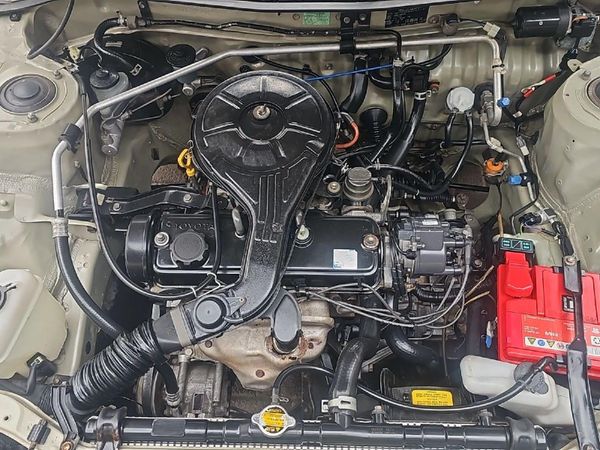How the Toyota Tazz Became a Staple in the Compact Car Market
How the Toyota Tazz Became a Staple in the Compact Car Market
Blog Article
Explore the Most Recent Fads in Engine Technology Through Tazz
In the rapidly progressing landscape of auto modern technology, Tazz stands at the center, highlighting significant improvements in engine systems that focus on both advancement and sustainability. From hybrid engines that optimize fuel performance to the introduction of hydrogen gas cells, the fads shaping modern-day powertrains are not just enhancing performance however additionally resolving critical environmental difficulties.
Crossbreed Engine Innovations
Hybrid engine technologies represent a crucial shift in automobile modern technology, incorporating the advantages of internal combustion engines with electric propulsion systems. This combination not only improves fuel efficiency yet additionally decreases discharges, conference significantly rigid ecological guidelines. By utilizing both power sources, hybrid engines can optimize efficiency, supplying power when needed while preserving gas during less demanding motoring problems.
Current improvements in crossbreed technology consist of enhancements in battery effectiveness and regenerative stopping systems. These advancements permit for higher energy recuperation during deceleration, which can be rerouted to help in acceleration or power auxiliary systems. Producers are concentrating on small styles and light-weight products to make the most of the effectiveness of crossbreed powertrains.
The growth of plug-in crossbreeds has actually also expanded the market, allowing motorists to bill their lorries using common electric outlets. This attribute frequently enables for considerable all-electric variety, additional reducing reliance on standard fuels. tazz. As the vehicle market remains to progress, hybrid engine innovations are anticipated to play a critical duty in linking the void in between traditional cars and completely electric models, providing a transitional solution that provides to varied customer requirements and preferences
Advances in Electric Powertrains
The automotive landscape is swiftly advancing, with electrical powertrains arising as a leading pressure in lasting transportation. Advancements in electric vehicle (EV) modern technology are dramatically improving performance, performance, and user experience. Trick developments include renovations in battery chemistry, which have raised power density, lowered charging times, and expanded general battery life.
Solid-state batteries, as an example, guarantee to transform the marketplace by offering better security and efficiency contrasted to traditional lithium-ion cells. Moreover, developments in regenerative stopping systems are enabling lorries to recover power during deceleration, adding to overall performance.
In addition to battery modern technology, electric motor styles are coming to be more advanced. Technologies such as integrated motors and advanced thermal monitoring systems are aiding to optimize power shipment and minimize weight, inevitably enhancing car characteristics.

Jointly, these developments emphasize the dedication to shift in the direction of cleaner, extra efficient transport solutions, placing electrical powertrains at the center of automotive innovation.
The Rise of Hydrogen Gas Cells
Increasingly, hydrogen gas cells are obtaining traction as a viable choice to typical inner burning engines and battery electrical cars. This innovation harnesses the chemical power stored in hydrogen, transforming it right into electrical power through an electrochemical response with oxygen. The key by-product of this process is water, making hydrogen gas cells an eco-friendly alternative with absolutely no discharges at the tailpipe.

Automakers are progressively spending in hydrogen gas cell technology, acknowledging its possibility for long-range applications and quick refueling capabilities that match traditional gas. In addition, sectors such as his response heavy-duty transport and public transit are especially fit for hydrogen gas cells, where battery electrical remedies might fall short due to weight and range restrictions.
As research study and investment proceed to broaden, hydrogen gas cells are positioned to play a considerable function in the future landscape of tidy transport and power options.
Enhancements in Internal Burning Engines
Advancements in inner burning engine (ICE) innovation are changing standard lorries to fulfill modern-day environmental criteria and efficiency expectations. One of the most significant improvements involves the assimilation of advanced gas shot systems. These systems enhance the air-fuel blend, enhancing combustion efficiency and causing minimized emissions. Direct gas shot, as an example, permits better atomization of gas, causing more complete burning and improved power output.
Furthermore, turbocharging has actually obtained importance, allowing smaller engines to provide higher efficiency without the weight of larger engines - tazz. This technology not only boosts effectiveness but also adds to reduce gas intake. Variable shutoff timing systems are additionally being fine-tuned, enabling engines to adapt to different driving problems for enhanced torque and responsiveness
Moreover, making use of lightweight materials in engine building and construction is ending up being typical, more recommended you read boosting fuel effectiveness by reducing general lorry weight. Engine control units (ECUs) are significantly sophisticated, allowing real-time modifications that optimize efficiency and emissions.
These enhancements jointly signify a critical change in ICE technology, lining up with international sustainability objectives while click site still offering the performance drivers get out of their automobiles. As the sector evolves, these enhancements remain to shape the future of traditional auto engineering.
Future Fads in Engine Efficiency
Significant improvements in engine effectiveness are prepared for as suppliers focus on integrating advanced modern technologies to fulfill rigid environmental laws and consumer demands. The shift towards electrification, crossbreed systems, and alternative gas is improving the vehicle landscape, driving advancements that enhance fuel economy and lower exhausts.
One of the vital fads is the application of sophisticated products and manufacturing strategies. Light-weight compounds and high-strength alloys add to lowered car weight, therefore boosting overall performance. Furthermore, the fostering of turbocharging and variable valve timing innovations permits boosted power outcome from smaller sized engines, additionally improving fuel economic situation.

Conclusion
Developments in crossbreed engine systems, electric powertrains, and hydrogen gas cells show a commitment to reducing emissions while boosting performance. Renovations in internal burning engines and an emphasis on lightweight materials add to total engine effectiveness.
From crossbreed engines that optimize gas performance to the emergence of hydrogen gas cells, the fads forming modern powertrains are not just boosting performance however also addressing essential environmental difficulties.Hybrid engine developments stand for an essential change in automobile technology, integrating the advantages of internal burning engines with electrical propulsion systems.Furthermore, turbocharging has gotten prominence, permitting smaller engines to supply higher efficiency without the weight of larger engines. Additionally, the fostering of turbocharging and variable shutoff timing modern technologies permits for boosted power outcome from smaller sized engines, even more enhancing gas economic situation.
Improvements in interior combustion engines and a focus on light-weight products contribute to overall engine performance.
Report this page